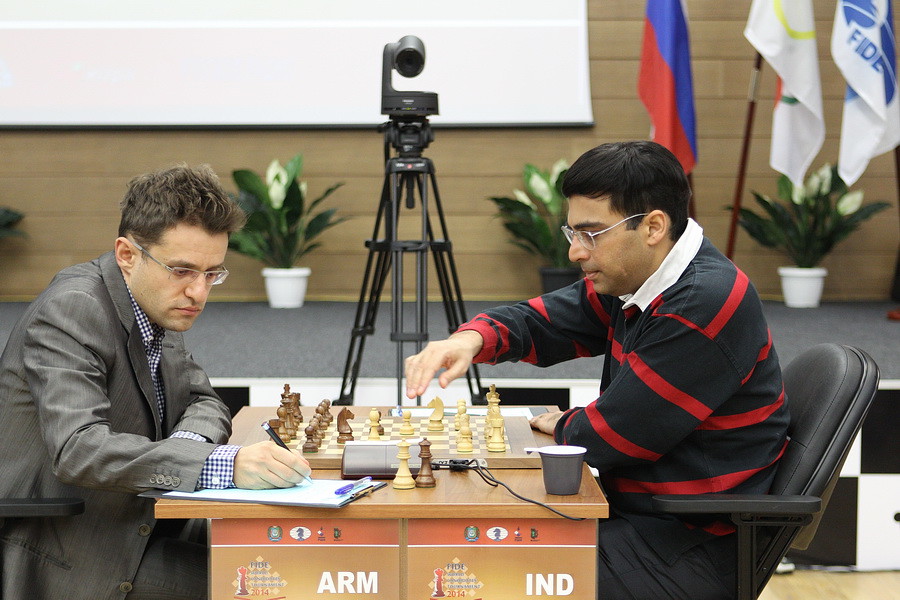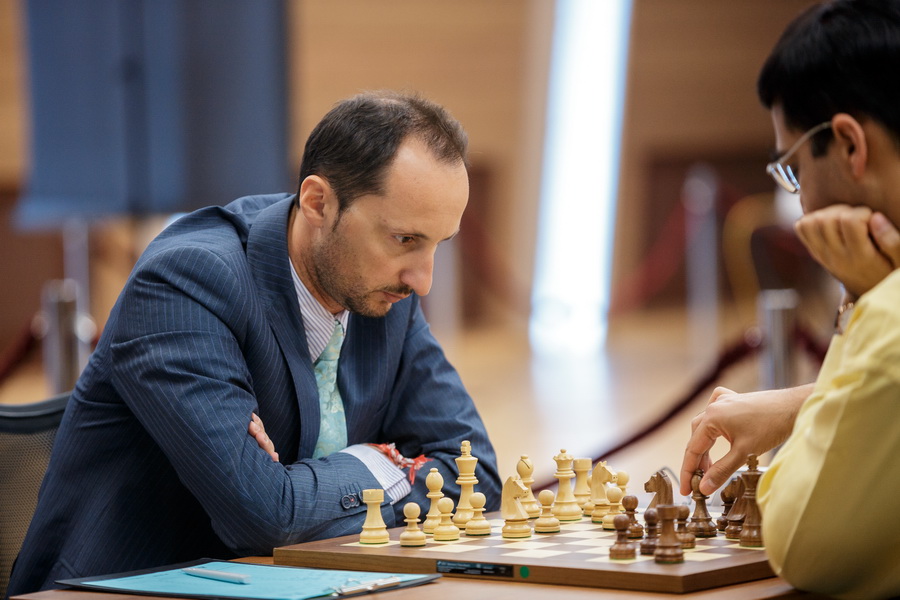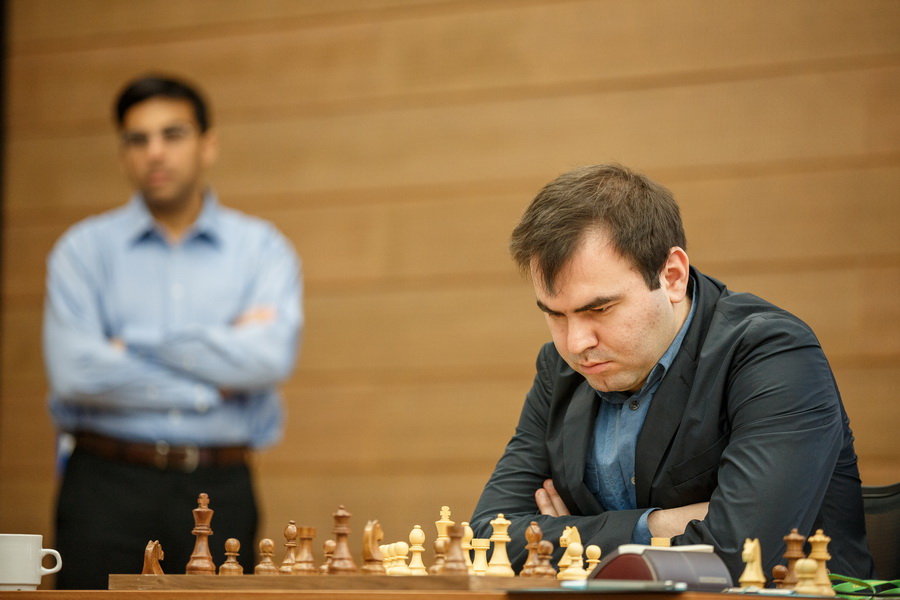" It's the eye of the tiger,
It's the thrill of the fight,
Rising up to the challenge of the rival !! "
A round of applause for Anand in the press center! #candidates2014
— candidates fide (@candidatesfide) March 29, 2014
Former World Champion Viswanathan Anand claimed a convincing victory in the FIDE World Candidates Tournament 2014... http://t.co/FnO1XAxH08
— Chess Club Live (@ChessClubLive) March 29, 2014
Anand back in action!! draws Karjakin, qualifying for World Championship 2014. #CarlsenAnand rematch #GoAnandGo
— Tanay Hargunaney (@TanayHH) March 29, 2014
Anand is back to #3 in the world after clinching rematch against Carlsen http://t.co/fqehxUERi1 via @fide_chess @chessdom #candidates2014
— Susan Polgar (@SusanPolgar) March 29, 2014
What is most surprising is that Vishy didn't even show his all-time best here & still won with a round to go!!! #Candidates2014
— Natalia Pogonina (@Pogonina) March 29, 2014
As we complete the penultimate round of the Candidates Chess 2014, I am sure that none of is must have predicted such a result. A decisive result with one round yet to go. Various chess critics, chess authors, commentators, players and fans had their own views about Anand's current play and form, from the tournaments he played after losing to Carlsen in the World Championship Match at Chennai, India. But Viswanathan Anand a.k.a Vishy Anand played some really solid chess, made practical decisions and successfully cracked the Candidates Chess tournament 2014 at Khanty Mansiysk.
Comparing Anand's Candidates Journey to that of Carlsen's
Candidates 2013: At the end of 14 Rounds in Candidates Chess tournament 2013, which was held in London Magnus Carlsen and Vladimir Kramnik were tied at 1st position with 8.5/14.
Carlsen won 5 games, lost 2, and drew 7 games. He maintained a very good, balanced chess games till round 11. Unfortunately the tables turned in the last leg rounds 12,13,14. Where he lost to Ivanchuk, and Svidler in round 12 and 14 respectively. It was in these rounds Kramnik could catch up to him. At the end of 13 rounds, both Carlsen and Kramnik were tied, at 8.5/13. The last round paired as, Carlsen-Svidler and Ivanchuk-Kramnik in a very dramatic situation both these table top players lost their matches. And Carlsen won the tournament on tie break scenario then pre-decided by the host.
Candidates 2014: From round 1 onwards, Anand maintained a lead in the tournament. Defeating Levon Aronian in round 1, and Mamedyarov in round 3. From here on he maintained a sole lead throughout the tournament. Anand played some real good chess, making sensible decisions and not risking his tournament life at stake many times. At the end of 13 rounds, Anand is now 1.5 points ahead of the 2nd position with 8.0/13. The outcome of the final round will not affect the tournament standings, and thus Anand has earned the right to challenge current world champion Magnus Carlsen for a rematch in November 2014. In 13 rounds Anand won 3 games, drew 10 games, lost 0. A record much better than previous Candidates winner, Carlsen
Image Courtesy: Official Candidates 2014 website, candidates2014.fide.com
Anand's World Championship Journey !!
2000: Anand won the FIDE World Chess Championship in 2000 for the first time after defeating Alexei Shirov 3½–0½ in the final match held at Tehran, thereby becoming the first Indian to win that title.
He failed to defend the title in 2002, losing in the semifinals.
2007: Anand won a double round robin tournament, held in Mexico City. Anand's victory in Mexico City made him undisputed World Chess Champion. He became the first undisputed champion to win the title in a tournament, rather than in matchplay
2008: Kramnik was the challenger to Anand, and Anand defended his title by scoring 6.5/11 in a 12 game, Match format in Bonn Germany.
2010: Anand faced Topalov in Sofia, and convincingly defended his title yet again by scoring 6.5/12 in a 12 game, Match format.
2012: Boris Gelfand won the Candidates Games 2011, and earned the right to challenge Anand. Anand again defended his title, but this time the games went upto tie breaks. 6-6 was the score after 12 classical games and tie breaks were to play 4 rapid games. Anand score 2.5/4 in the rapid games thus retaining his title.
2013: The winner of Candidates 2013, Magnus Carlsen a.k.a Mozart of chess, earned the right to challenge Anand. The 12 game match took place in Chennai, India. Carlsen won this with a score of 6.5/10
Anand is the only player to have played and won the world champion title in all formats, knockout tournaments, round robin tournaments, and match format. He has been an elite and versatile chess player for almost 2 decades now. It is of great pride for Anand's fans in India and across the world to have seen the "Tiger of Madras" win the Candidates 2014 convincingly and earned the right to regain his title back.
Eagerly awaiting the Carlsen-Anand rematch in November this year. Best wishes to Anand and his team for the match ahead. And Kudos on a mind blowing victory in Candidates 2014, Congrats !! What a comeback, really glad to see this form.
" And the last known survivor
Stalks his prey in the night
And he's watching us all with the eye of the tiger "
Stalks his prey in the night
And he's watching us all with the eye of the tiger "
Written by
A Die Hard Anand fan !!
Follow me on twitter: @TanayHH
PS: All the views above mentioned are my own, otherwise facts mentioned.





































